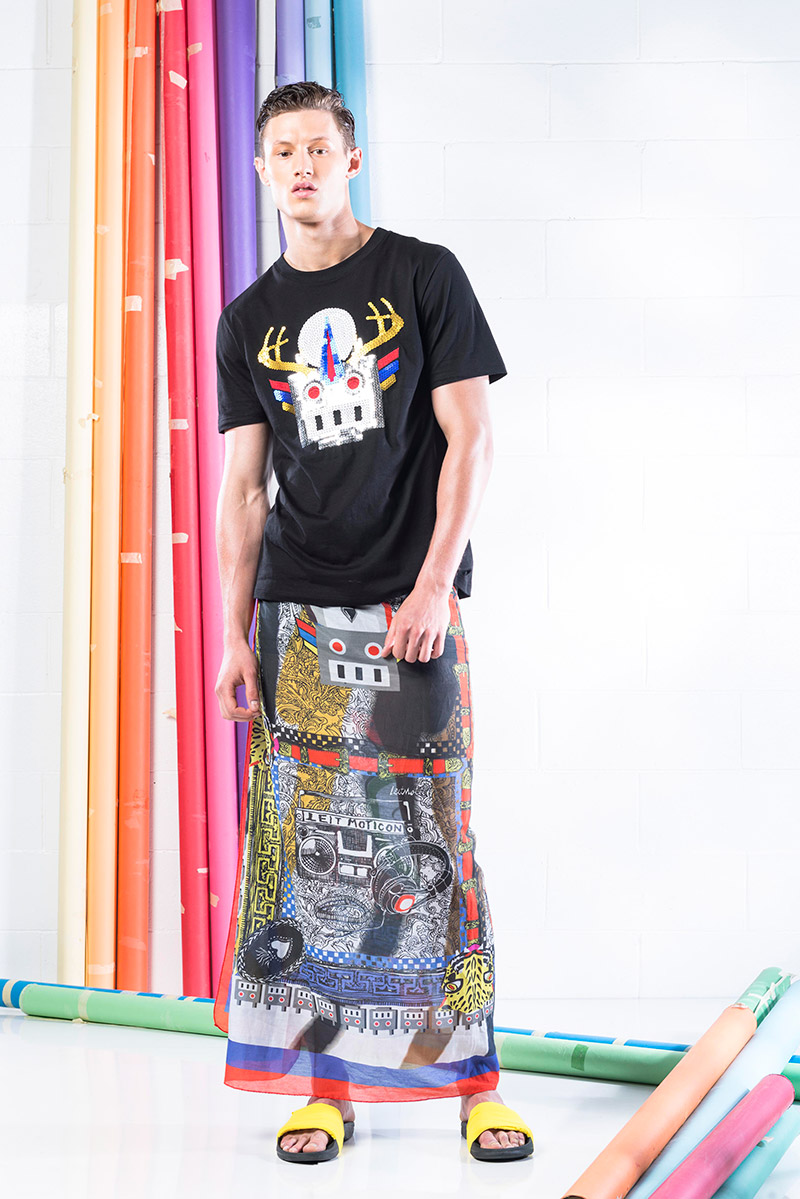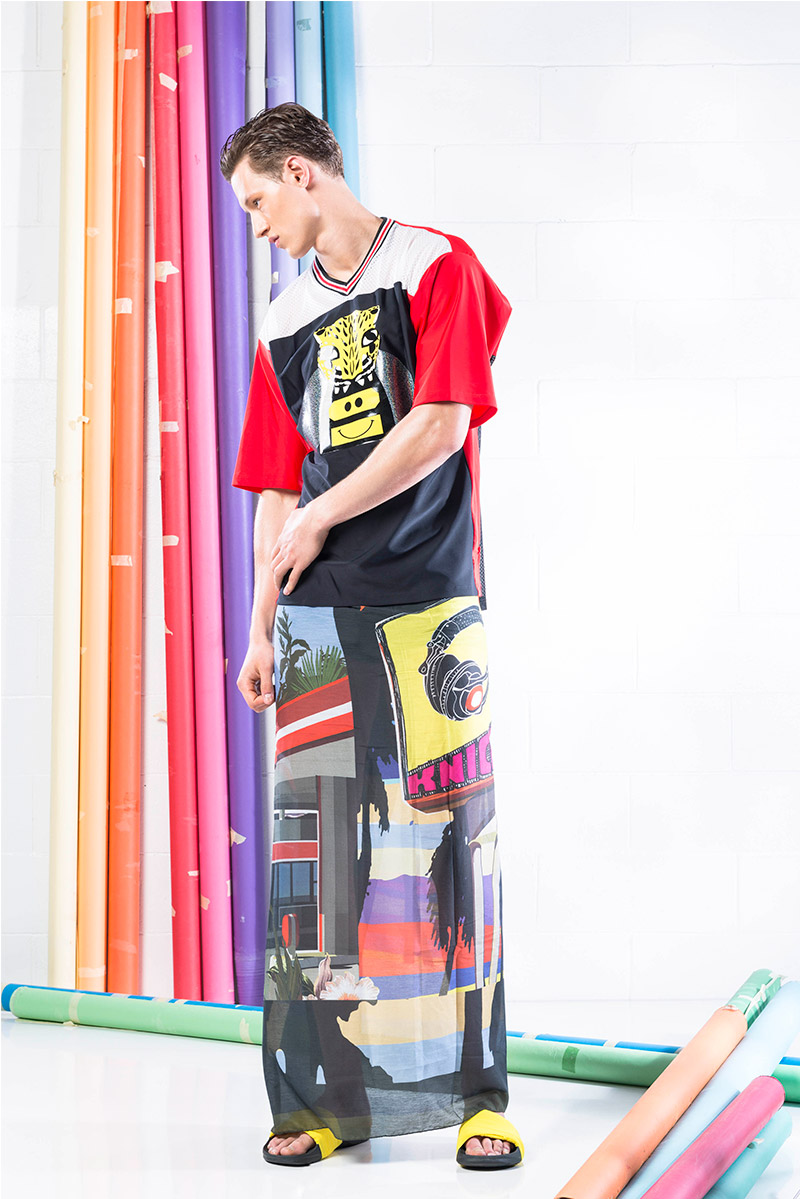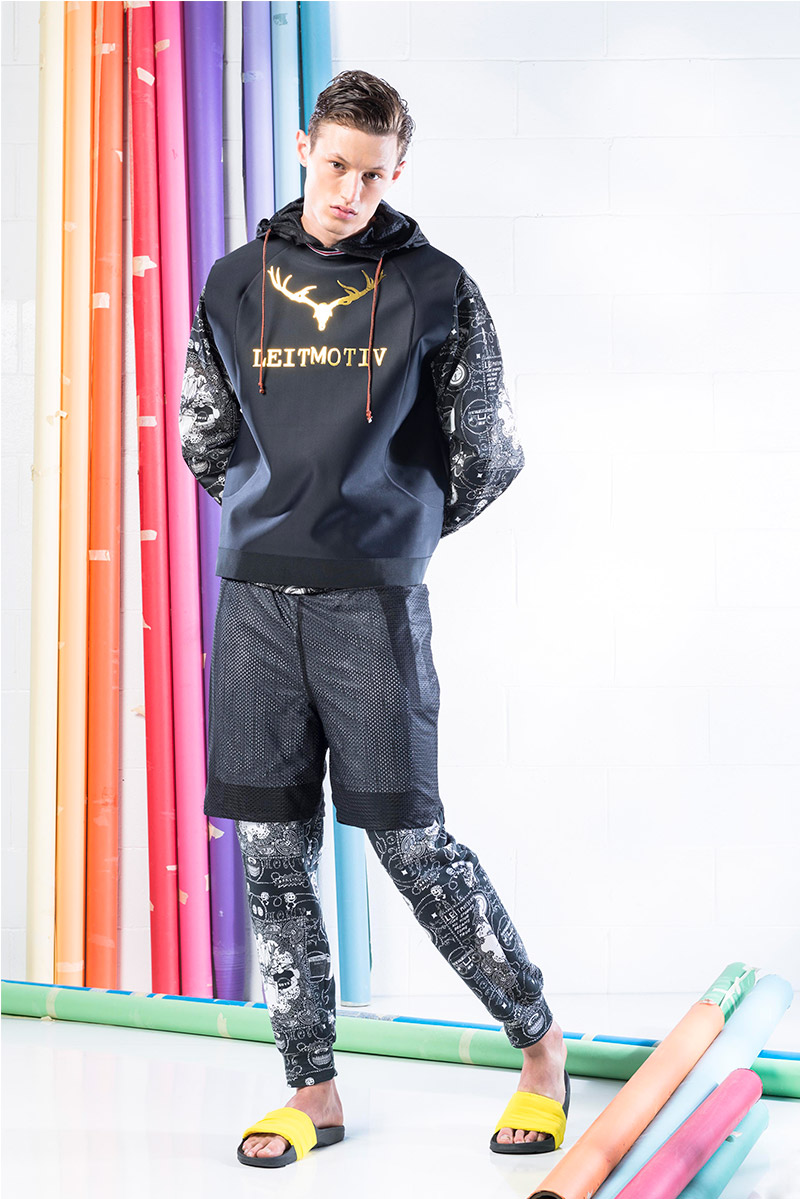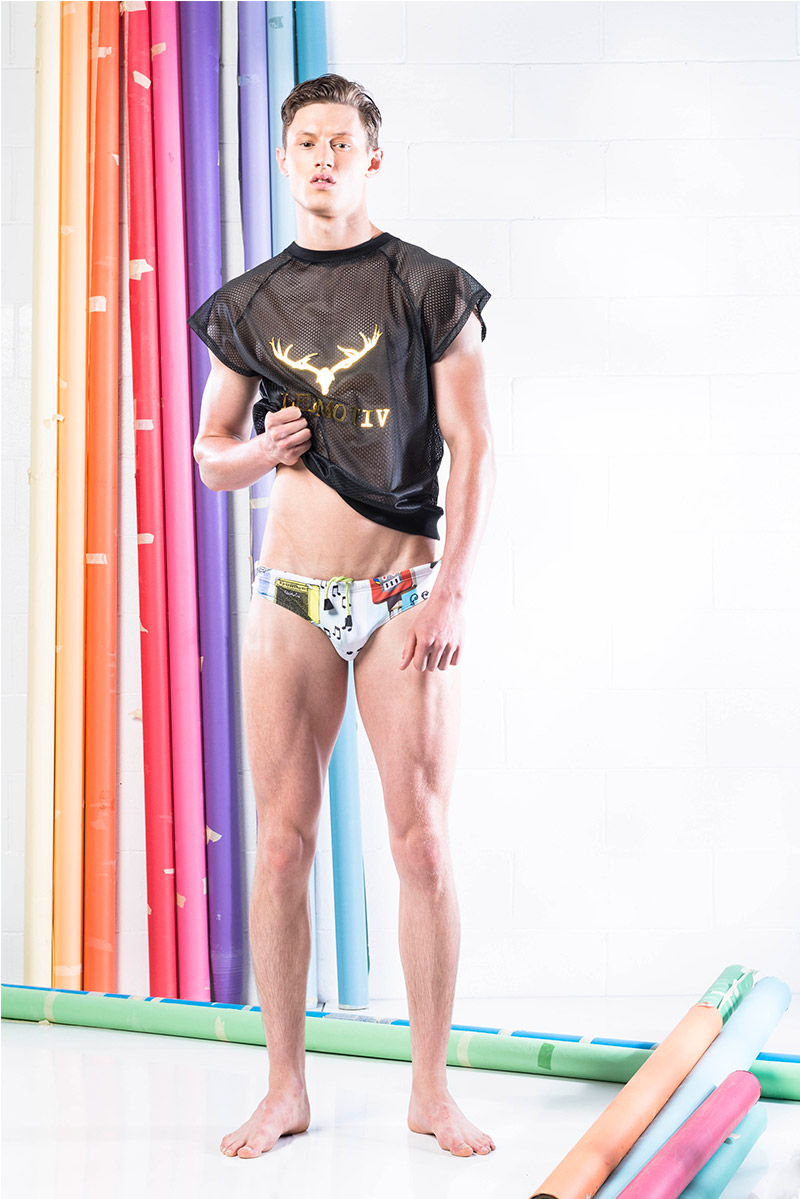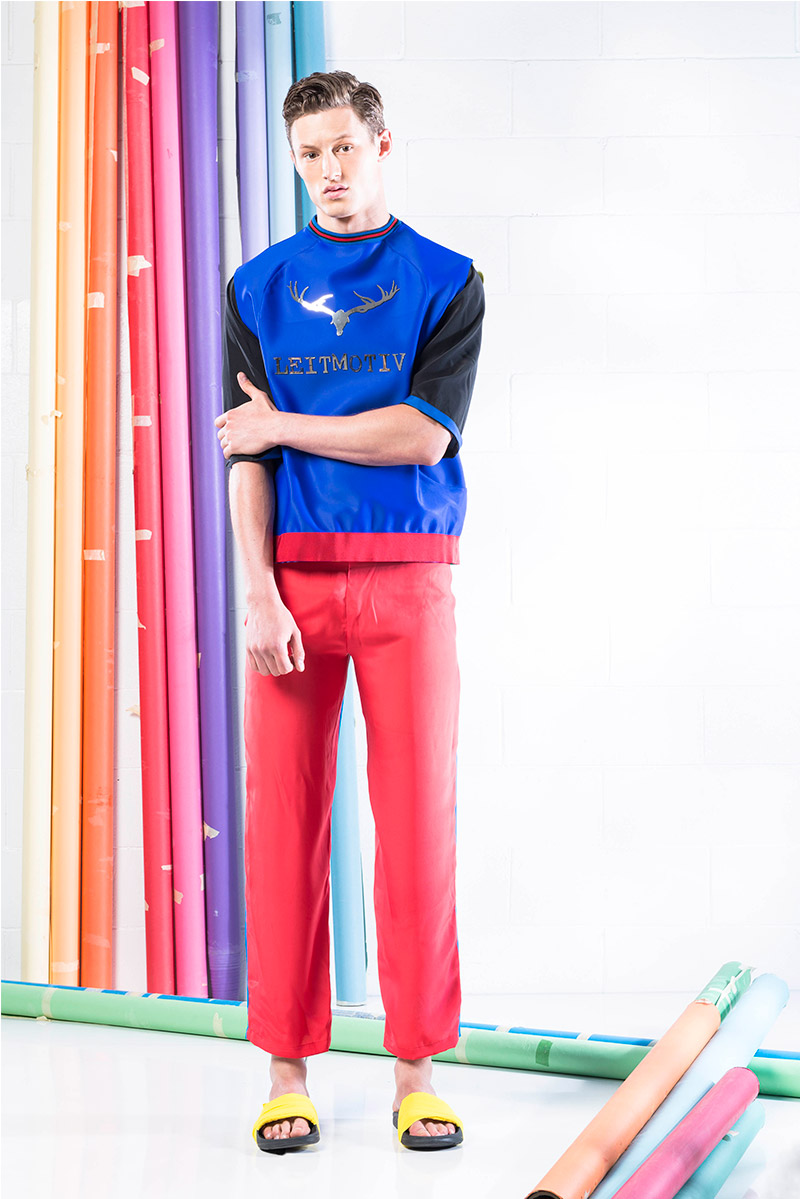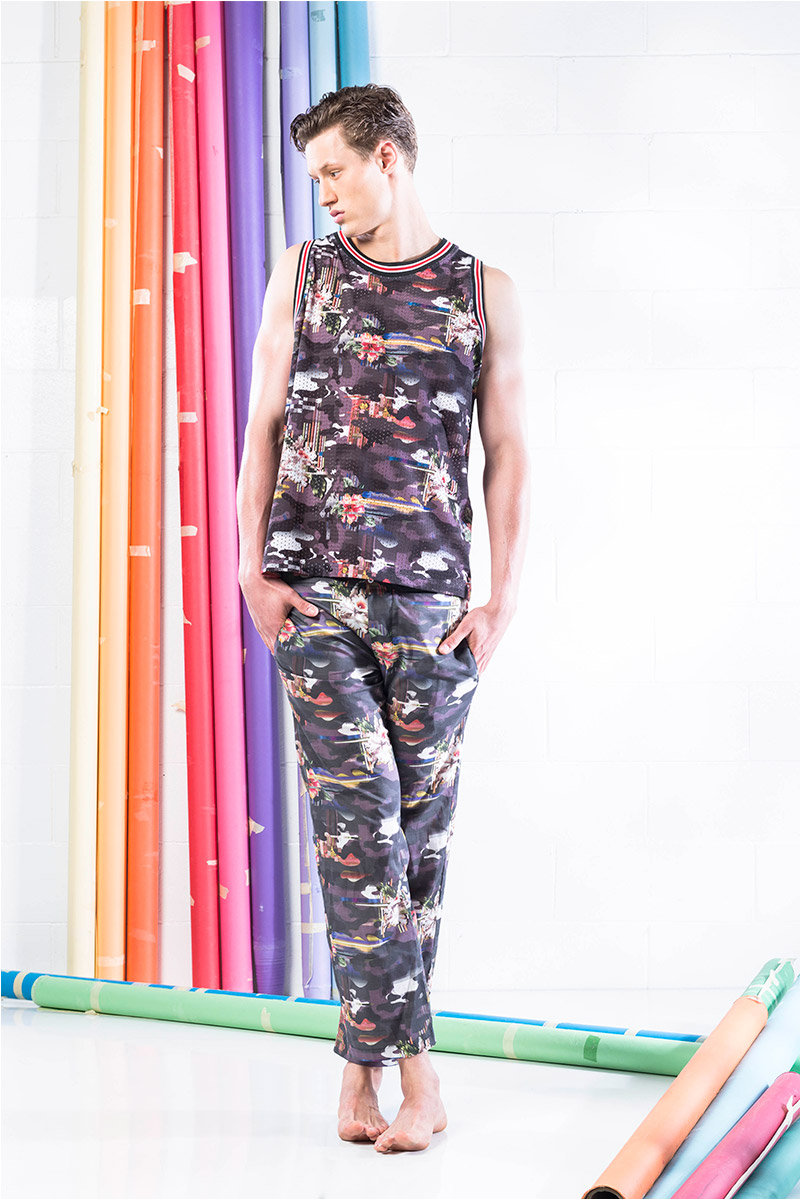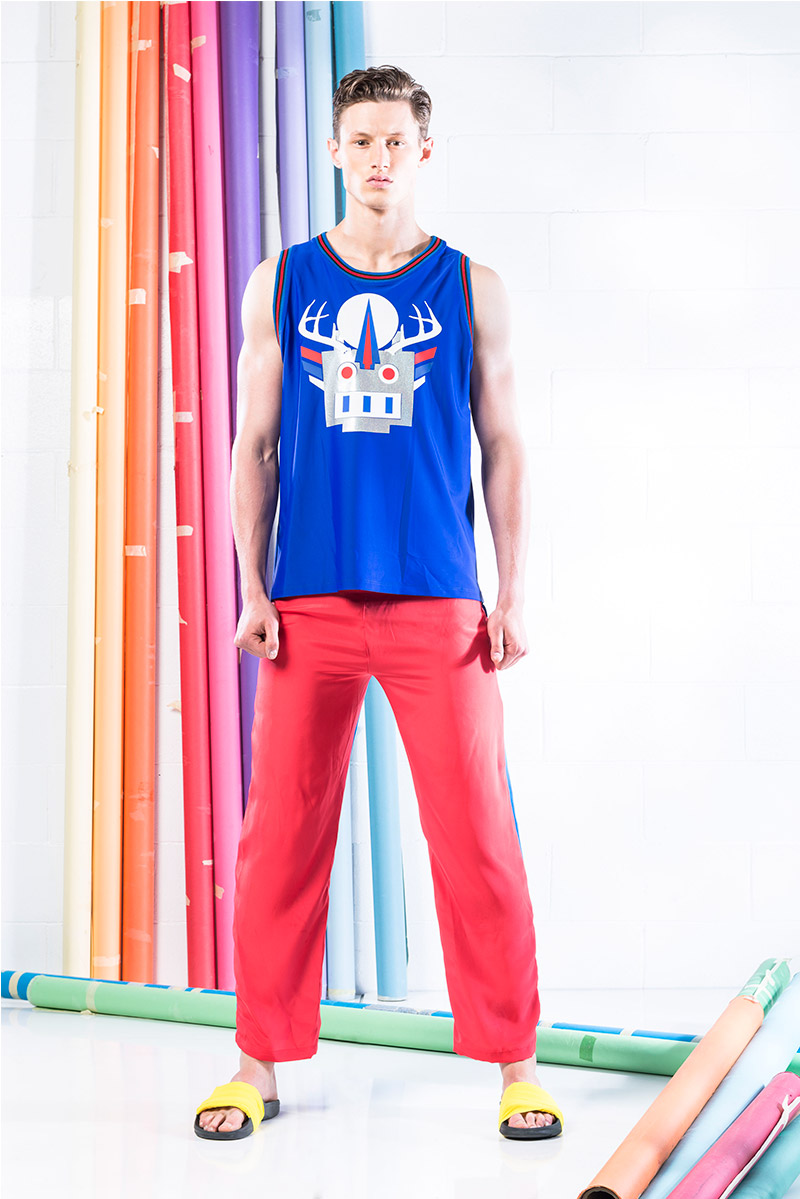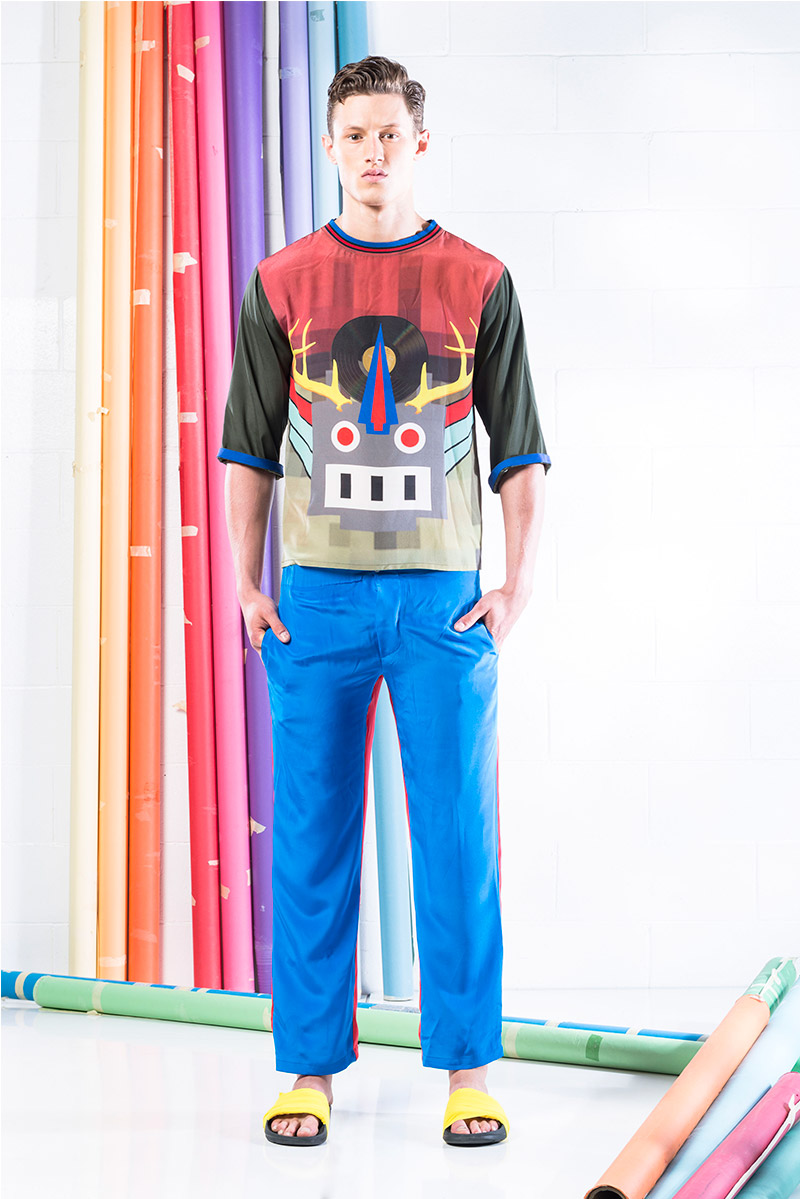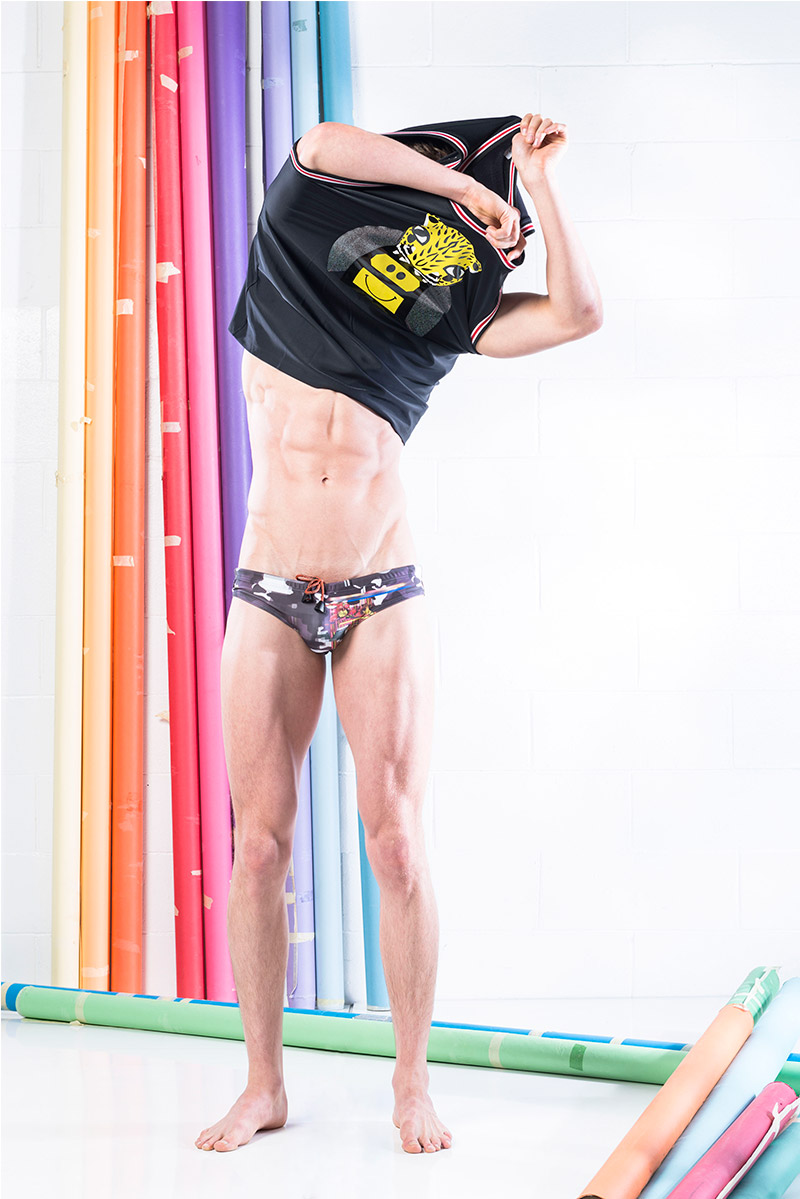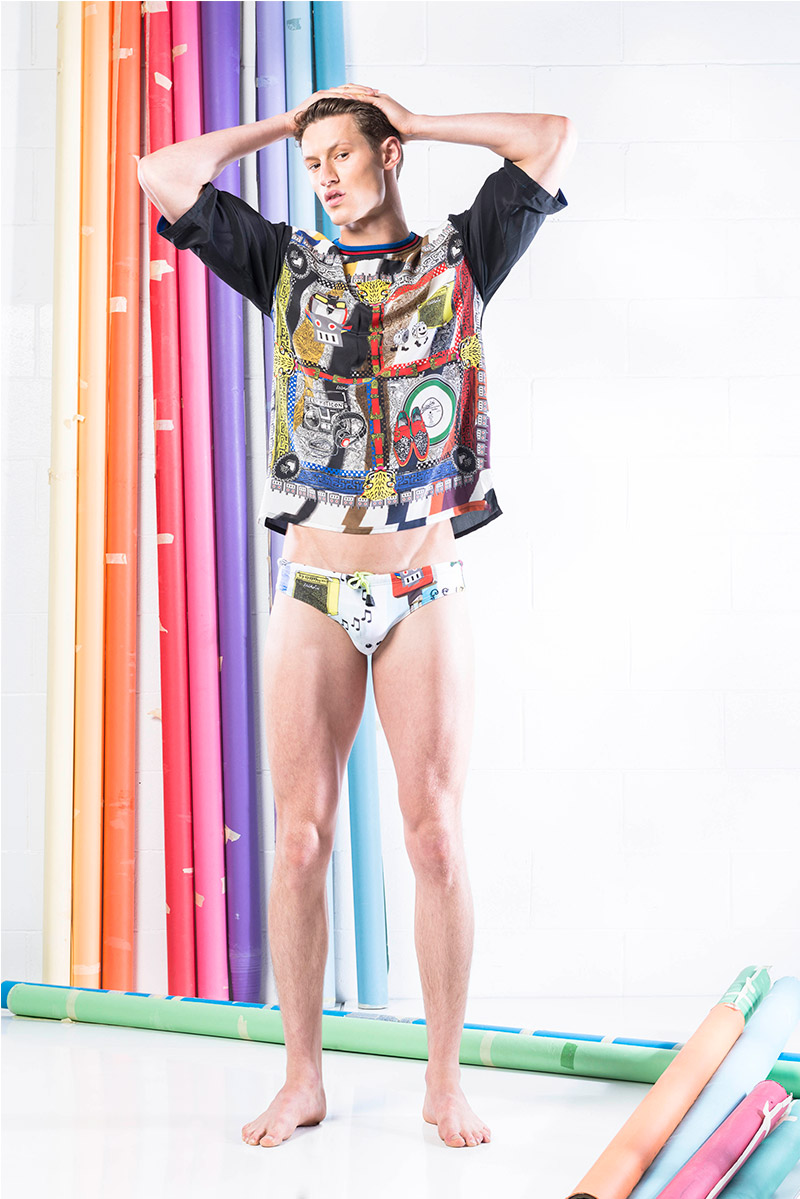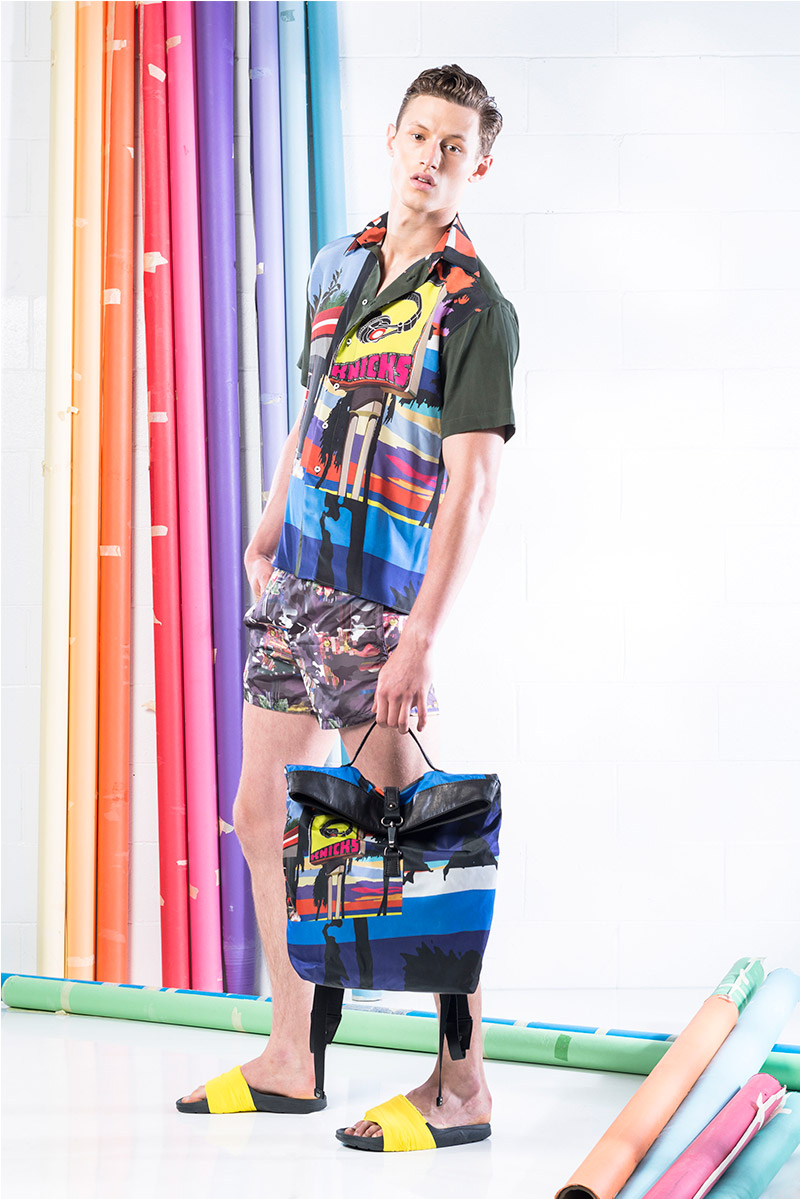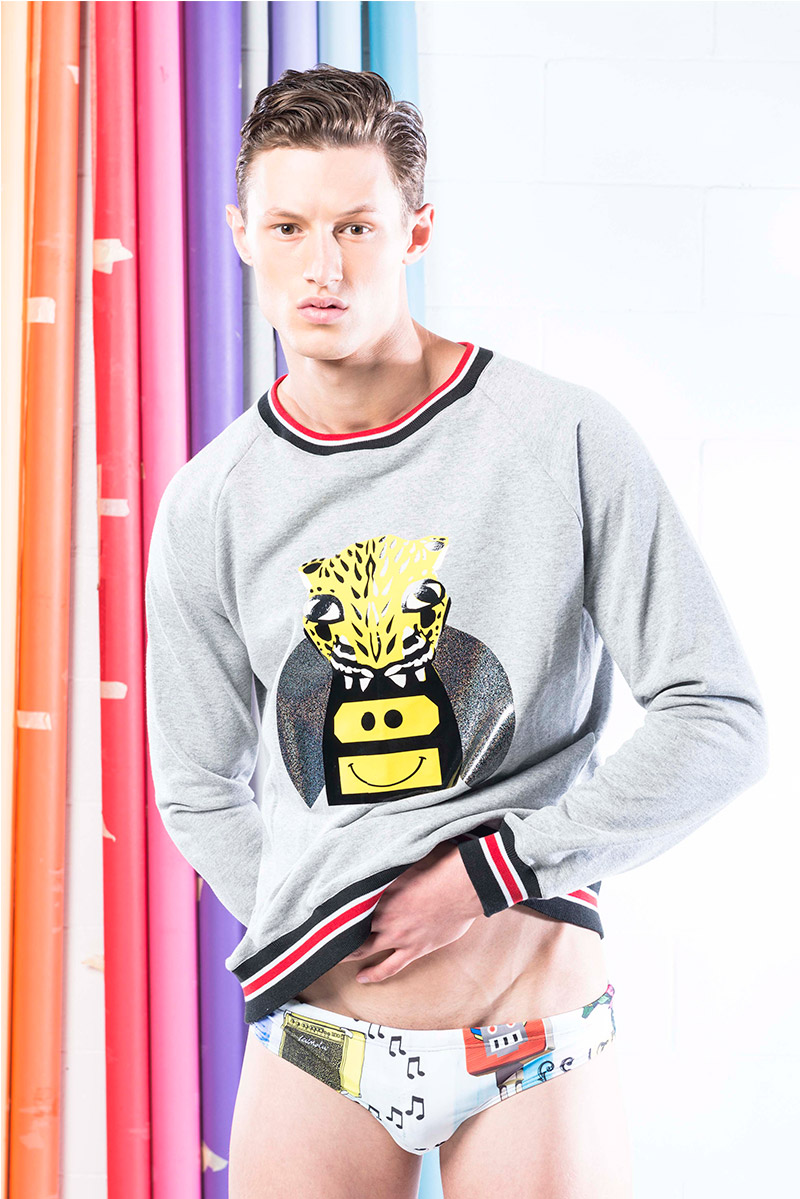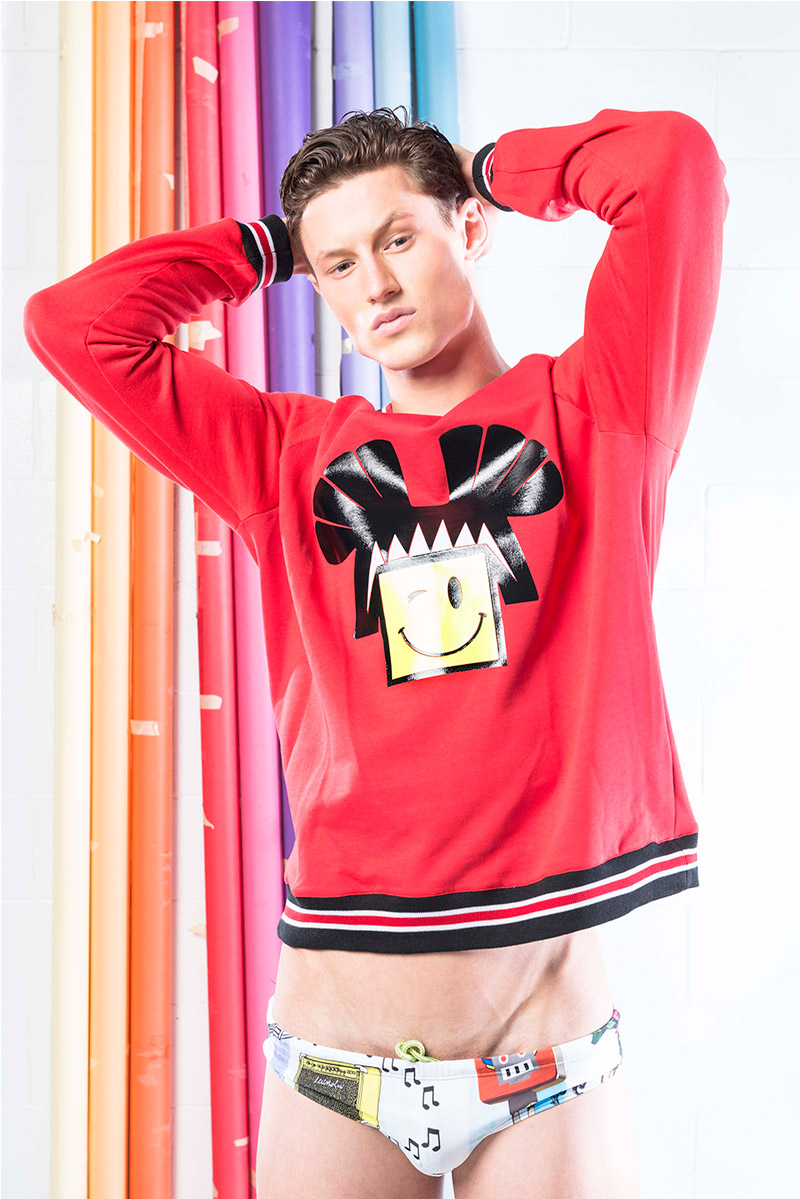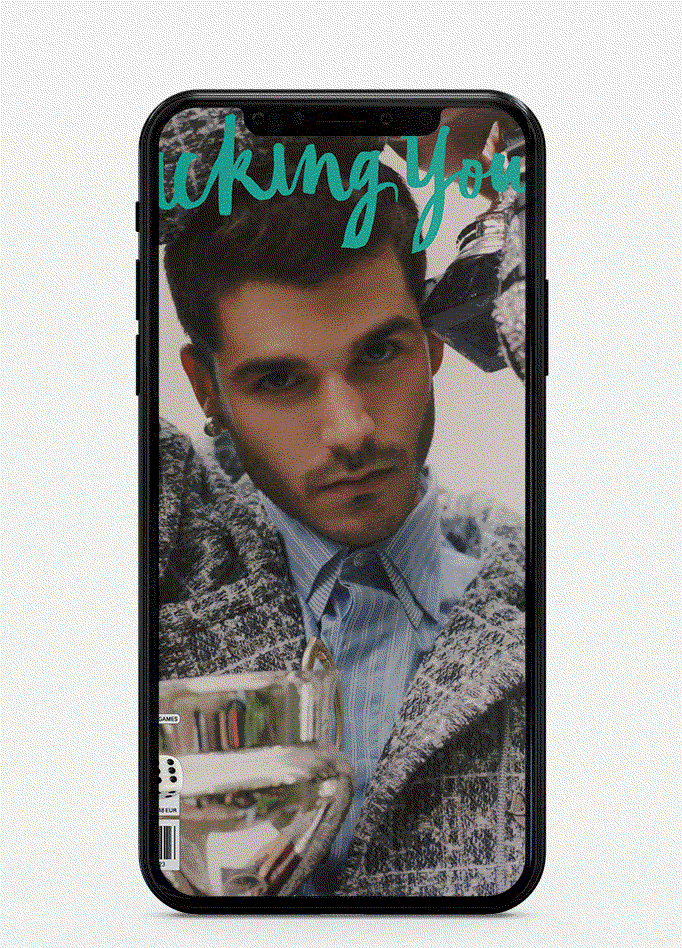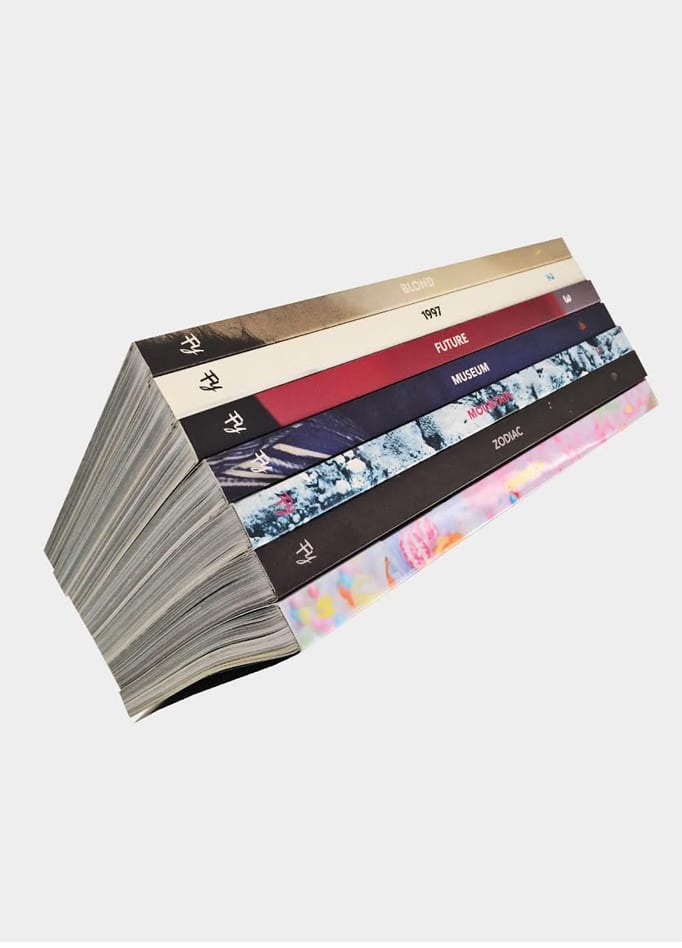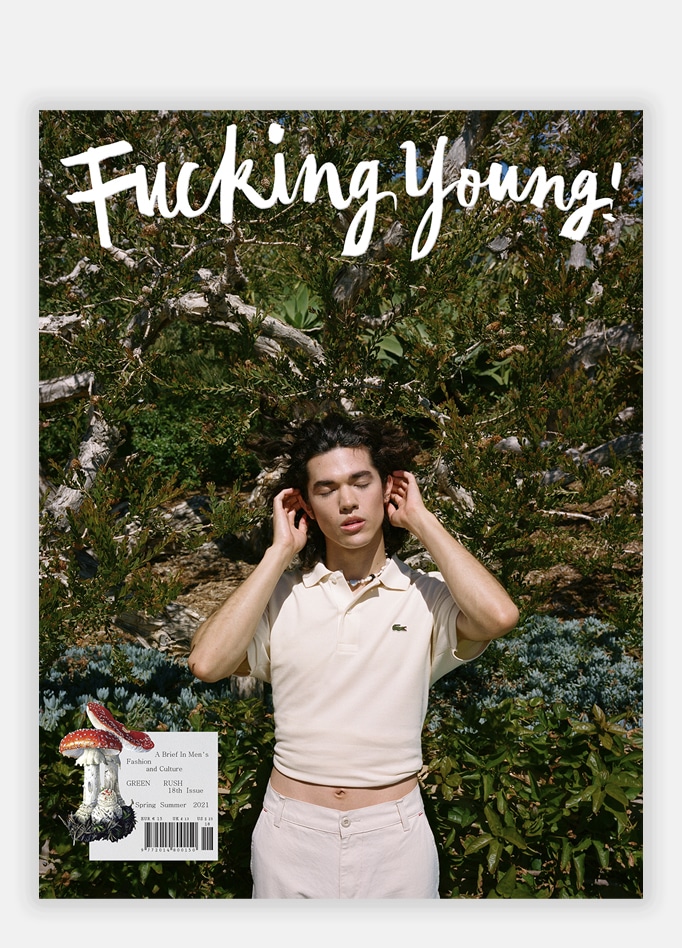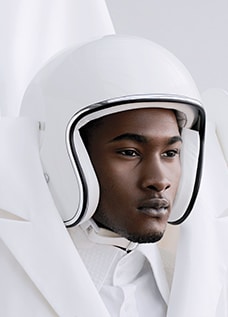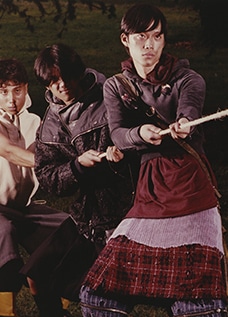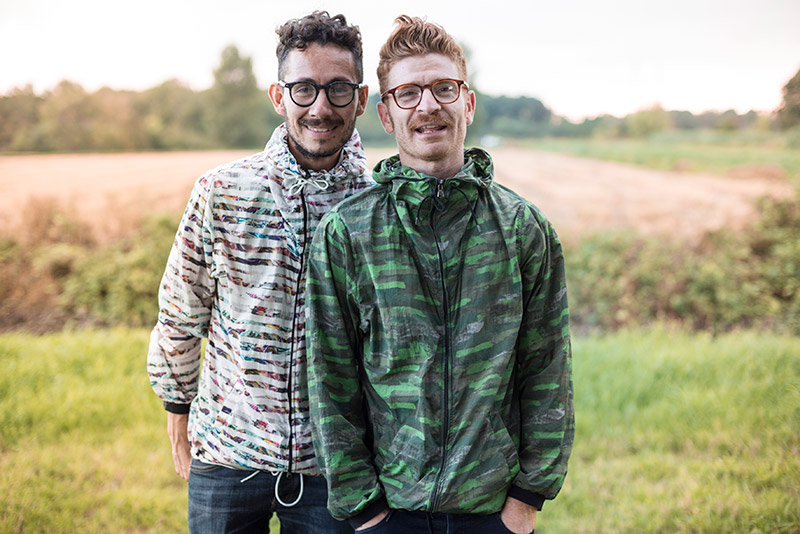
Leitmotif, a recurrent theme throughout a musical or literary composition, associated with a particular person, idea, or situation.
Adhering to the Oxford Dictionary, the definition appears as clear and reassuring but in Italy the term Leitmotiv (the last consonant is different) seems to have shaken that a bit nostalgic dust off to take a fresh and innovative meaning. It happened of course when Juan Caro and Fabio Sasso chose it as the name for their brand.
Founded in 2007 in Bologna, Leitmotiv was born with the aim to create clothes and accessories able to tell stories through prints characterized by a purely artistic taste. And art is the true leitmotif, the common thread that binds every single item, every single collection. Art is in Juan’s and Fabio’s DNA. It’s in their studies: painting for the former, history of art for the latter. It is in that creative process that causes them to think out of the box.
For the SS15, they reinvent the world of the emoticons by creating a new generation of symbols. The mood is fresh and the lines refined. To inspire the garments creation is especially the basket-world: nylon jackets, hoodies, t-shirts and shorts. The shirts have daring colors. The ink handmade drawings become bizarre digital prints because – as Juan pointed out – you have to be sure that art is in every season.
Fucking Young! – Welcome guys! Let’s start… When and how was Leitmotiv born? Why did you decide to join forces?
Juan Caro – Leitmotiv was born in Bologna a few years ago, when we were at the university. Fabio was studying art history while I was studying painting. When we first met there was so much creativity and desire to do that they needed to be put into practice and then we wondered what we could do together. This way it sprang a very cool project consisting in an exposition of accessories connected to a series of works of art in a Gallery. This was the initial concept from which then it developed the desire to continue, to do research and proposals that have gradually been extended to the clothing sector too. It all started in a very spontaneous way, just for fun.
Fabio Sasso – The first official step was then to win the contest Fashion Incubator sponsored by the Chamber of Fashion that has shaped, given us the opportunity to meet the buyers and approach this sector in a professional manner. The following year we were contacted by Franca Sozzani to participate in Who is on Next? Man, for which we received the special mention, and AltaRoma. Two important stamps that made us appreciated in Italy as designers with a certain type of recognition. Since, I can remember we were at our fourth season, the brand had been growing gradually – parades, image campaigns, etc.. – up to the seventh season when re-sales officially started and the company began to exist, to charge, to sell, to collect. It then turned into the reality that even today we ourselves manage.
FY! – So, yours was a starting point associated with art… Is it then possible to make art through fashion?
JC – I find it curious that when asked, a lot of great designers absolutely deny the relationship between art and fashion by suggesting that fashion is fashion and art is art. It is strange, especially if we think about the creative process of all the designers and their stylish offices carpeted with artistic images with a clear focus on everything that is art, on the colors, on the shapes, on the study of the volumes. It is good to recognize that fashion is nourished by art and in our case we want to make this marriage clear because, as I explained before, we come from art. All the iconographic research at first blush stems by libraries and visual sources. All this is then translated into a figurative language crafted by me. For example, in the SS15 collection the designs are born as ink drawings and then turned into digital prints… In my opinion, there is thus an enormous correspondence between the two. However, and it must be said, there are some cases of stylists who carry out completely different researches.
FY! – As you mentioned earlier, you “faced” two very important contests in Italy, two talent-contest, we could say. How important was this for you and how much important might it be for the future generations?
FS – In a system like the Italian one, it is very important to have institutions such as the Chamber of Fashion and Vogue that help and follow the talent. They provide you with inputs, then it’s your turn to move the next step. In our case, thanks to the Chamber of Fashion and Vogue before and other no more Italian realities after, we were able to be formed, grow and establish ourselves. It is clear that they always need fresh names, that they cannot support you for a lifetime and that every twelve months they exalt other twelve different creativities but it’s your duty to keep on the market through the sale and the marketing of your product. This is our story… It is true that a lot of names have waned over the years but the internationally recognized institutions support is no doubt important.
JC – Through them it is possible to understand the value of communication and its importance for a brand. Of course, behind any product there is a design, a creative concept, and the one who communicates it must transmit this value to both the insiders and those who love fashion in general. Fundamental, almost a mission from this point of view, is the role of the journalist who has to communicate it. When we go around in other countries, for example, we happen to find often extraordinary, extremely interesting products but with no institution supporting them. What is their fate then? Staying in themselves. On the other hand, there are countries where this system works very well, where the native talents are exalted in an excellent manner.
FY! – How do you interact with each other? Which is the reciprocal contribution to the creative process and to the brand in general?
FS – It changes continuously. In the last year the company has grown a lot and we are lucky to have a capable staff on our side. We decide the concept after a trip, a situation, a lived experience and since that moment Juan starts with his creative process. There is a continuous and daily dialogue with respect to what he does the same way as there is a continuous and daily dialogue with respect to what I myself do for the company in general. He is responsible for the creative part that clashes with my personality which is completely different from his. Many of our customers are able to guess which of the inputs are driven from the one or the other. At the same time the encounter/clash takes place about the final image we intend to give the collection will be.
JC – For me it is a perfect combination because, for example, if in a period of hard work he moves away from the creative process, I feel “lost”. Knowing myself, my character, if I stop for a moment to observe how far I have gone I usually think, “No, that’s not good”. I miss that element, that indispensable, essential, unique touch. Let’s say I make a creative brief that must be then approved by the chief.
FY! – The crisis can be seen as a simple mental state. However, in a delicate phase, in a saturated and crowded market, what do you think the right move to make yours a winning brand is?
FS – My answer may seem grim but for the moment I think it’s important not to put yourself in the hands of anyone else. We are a company that creates and produces by itself… Everything that comes in and out is ours. This is certainly a difficult move, a very tiring one but I am convinced that it rewards. In a market like the current one, in our way we are growing. For our company, everything will come, and to the great, but slowly. There’s no envy, there is no comparison with others because we are not interested. We are sure about our background, our history, and the fact that the brand must make its steps to reach the economic potential it reaches every six months.
JC – This line of reasoning is obviously the result of experience. At first the world of fashion can seem to be destabilizing. You need to take a route forcing you to get your feet firmly on the ground. You need to go through some processes inevitably characterized by pain. It is a path paved with difficulties, it is not like choosing either the yellow or the blue. There’s a whole world moving around and that must be taken into account. Fortunately we have a team that helps and supports us … The crisis then, as you said, it’s a state of mind.
FS – Moreover we are young, we do not hurry. When I am seventy, I will still want to do this job and maybe have an empire but we have plenty of time to grow… Little by little we will get there. Certainly there is a stall market situation, at least in Italy, and we need to find the right trick to arrive where in fact there is a strong energy, evolution, an even economic push.
JC – It is clear that the capital move with more difficulty, that a scenario of this type exists. On the other hand, it is true, however, that people continue to spend their money. They go to the restaurant, to the cinema, on holiday. I rather think that in Italy habits have changed, so as the way we spend money. The discourse linked to the heavy chains of clothing relieved all the rest. You know that you can dress up and be fine while spending less. Indeed, you cannot blame those who think like that because when going to some stores you find that things on sale are very cute. But buying a special piece, one with the x factor, is something different… Be it the fabric, the style, the shape, the print. All of this must continue to exist because fashion is a weapon. At a time when we buy a garment that represents us, that makes us feel in some way stronger and more beautiful, we are able to place ourselves in a different, more confident way in front of the world. The real crisis probably lies in the fact that we often prefer clothes produced in series and equal to a hundred, a thousand others while believing that this is fashion at the expense of pieces with their own history and reason for being, capable of making you feel unique.
FY! – The international market where you feel stronger?
FS – Our main market is the Eastern one, that is Korea, China, Japan.
FY! – And which the differences between the European and the Asian market, namely in such an era where the economic axis seems to tend to the East?
JC – I would define the Asian market as fascinating. In order to respond well and fully understand the different economic and social realities you should have the opportunity to travel a lot. In Asia, for example, we noticed that the fashion speed is so hectic that it completely changes from one season to another, the codes change. Asians are not only large consumers but also rich in ideas. They love creativity and experimentation. They have a different relationship with their body that makes the way they approach fashion very fascinating. If in the West fashion is almost seen as a weapon designed to enhance the quality of one’s body, in the East they go beyond this concept and everything becomes more abstract. They want to play and call themselves into question.
FS – Yes, while the Italian has a certainly defined stereotype, the Asian wants to get involved and be ironical also about his body which in general is different from the European and Italian one.
JC – Fascinating is also the European concept of fashion, linked to that tailoring and wearability that exalt the body: both factors that we appreciate so much. Then there are the young Asians who want to go over and in this desire they are receptive at 360°, very interesting.
FY! – With an adjective, how would you define the Leitmotiv brand?
FS – Eclectic.
JC – Even if it might seems banal, colored.
FY! – The prints represent your distinctive characteristic. By what do you get inspired and how does the inspiration come?
JC – It depends, it’s a mix. It is usually is a little personal recipe… It depends on the time, the mood, on what we can “breathe” in the air. I admit that lately we are fascinated by the digital communication and the social. We can notice that increasingly controlling our own web profiles has become the first act in the morning. We all want to know anything about the others, we all leave a comment, we all want to be up to date. In this latest collection, therefore, the world of social has become a source of inspiration, interpreted in a playful way… It wants to tell you: “We greet you with two smiles but in our way”.
FS – Yes it’s the social world revisited, a little less rigid than the ciber-real one.
FY! – We have said nothing about yet, why Leitmotiv?
JC – Well, the name Leitmotiv was born by chance. We had to register the brand and on the way to the Chamber of Commerce we were considering different names options. Since during the university courses it was a recurring theme – it is used to talk about music, film, art – it seemed a very effective name, able to represent us.
FS – And it’s a cultured name as well since it was, it is able to highlight our whole course of studies, our background.
JC – It is a word that we consider as very beautiful, that mirrors us as creative. We have said it before, there is a leitmotif in the art and so we have to be sure that art is in every season.
FY! – Now let’s explore together the SS15 Collection. We have already alluded to the prints, the inspirations, the mood. What are the most representative garments, colors, accessories? Tell us about…
FS – The basic idea is that of a basket man in transverse and daily clothes. The items are over, the wereability has changed. We move from the nylon undershirts to the garments in jersey embellished with sequins. He is a man who goes out in the morning and comes back in the evening after having lived a thousand vicissitudes: from the office to the gym, from the dinner to one evening with friends. The collection has, in general, a very young and playful style with an urban touch that manages to result in a universe parallel to the beach fashion with ad hoc items.
JC – According to me an interesting element, definitely current, is the one related to the intention to create a short circuit between the sports and the tailoring worlds. In the production of our garments we pay attention to details that are upline everything. This can be seen in the shirts where the prints are carefully positioned, cut, worked. Each garment remains still usable and easy to be worn. So, although a little abused, if we should use an adjective we might say that it is a street-chic collection: sporty garments, easy to wear but with their clear background. Items are educated, artistic, unique and at the same time useful.
Together – The most representative and effective one is probably the over hoodie that blends different types of materials, from the technical one to the sequins through which we reinterpret the world of social… It is an item that holds and tells a whole day.
FY! – The man, the boy wearing Leitmotiv?
JC – Each season we ask ourselves who he might be. The brand spirit is to go over both the categories and the genres. Our intention is to dress neither the femme fatale nor the fashion victim.
FS – As we were saying before, ours is a rather transverse product, especially in this collection. There is no precise identity of man or woman. The same fashion world is changing direction toward the daily life, a ready to wear which is different from the couture.
FY! – We ask it to you as we do to all our interviewed… For you guys, what is really FUCKING YOUNG!?
JC – Just let me say that I think the name of the magazine/website is absolutely brilliant. Why? For me the word “young” is the highest value in any culture. Being young means being able to fly high, what is young is always considered as beautiful, it’s a fantastic adjective… We, they all would like to be young… Fucking Young! When we meet a young man or woman in the street, beautiful, we cannot help but think: “What more do you want from life?”. The young have this way to live life which is fantastic.
FS – Absolutely! They have freshness, carelessness…
Thanks a lot!
See below the Leitmotiv Spring/Summer 2015 Collection:
